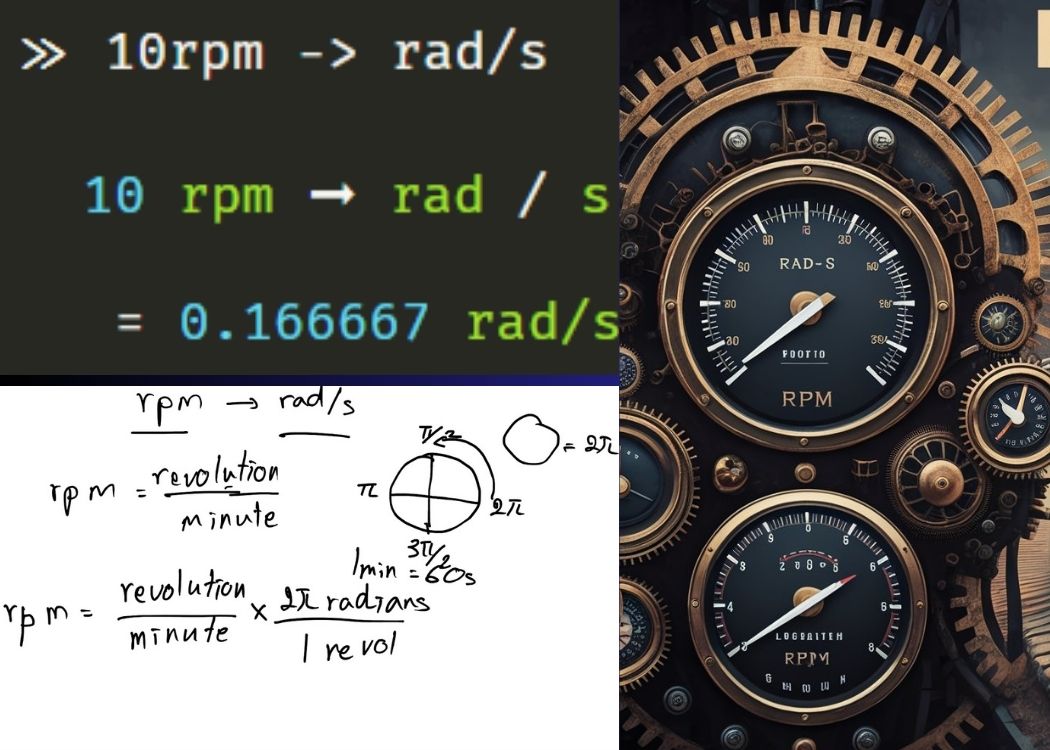To the fascinating world of angular velocity, where rotations and revolutions take center stage! If you’ve ever found yourself lost in the whirlwind of radians per second (rad/s) and revolutions per minute (RPM), fear not – we’re here to guide you through this captivating realm of rotational dynamics. So buckle up and get ready to dive into the intricate relationship between Rad/s and RPM, unraveling their secrets along the way. Whether you’re an engineer, a student, or simply curious about the science behind spinning objects, this article is your ticket to mastering the conversion from rad/s to RPM like a pro!
Understanding Rad/s and RPM
Angular velocity is a crucial concept in physics and engineering, measuring how quickly an object rotates around a fixed point. When discussing angular velocity, two common units are often used: radians per second (rad/s) and revolutions per minute (RPM).
Rad/s indicates the number of radians an object travels through in one second. Radians are a way to measure angles in terms of the radius of a circle. On the other hand, RPM measures how many full rotations an object makes in one minute.
Understanding the difference between rad/s and RPM is key when working with rotational systems like motors or gears. Converting between these units allows engineers to analyze and optimize rotational speed effectively.
By grasping the relationship between rad/s and RPM, you gain insight into how fast objects rotate and can make informed decisions when designing machinery or analyzing data sets related to rotational dynamics.
Converting Between Rad/s and RPM
Understanding the relationship between radians per second (rad/s) and revolutions per minute (RPM) is crucial in various fields like engineering, physics, and mechanics. Converting between these two units allows us to express angular velocity in a way that suits our specific needs.
To convert rad/s to RPM, you can use the formula RPM = (rad/s * 60) / (2π). This equation helps simplify the process of transforming angular speed from one unit to another seamlessly. Remember that 1 revolution equals 2π radians, which explains why this conversion factor appears in the formula.
Conversely, if you need to convert RPM to rad/s, you can rearrange the formula as rad/s = (RPM * 2π) / 60. By applying this calculation, you’ll be able to switch between these two common units with ease and precision.
Real-World Applications of Rad/s and RPM
Angular velocity measurements in radians per second (rad/s) and revolutions per minute (RPM) have numerous real-world applications across various industries. In the automotive sector, understanding these units is crucial for designing efficient engine systems and optimizing vehicle performance. Engineers use rad/s and RPM to calculate gear ratios, ensuring smooth acceleration and maximum power output.
In the field of robotics, angular velocity plays a key role in programming robotic arms to perform precise movements with speed and accuracy. By converting between rad/s and RPM, engineers can control the rotation of joints and ensure safe operation in manufacturing environments.
Moreover, in aerospace engineering, rad/s and RPM are essential for designing propulsion systems that deliver thrust at controlled rates during flight. These measurements help engineers determine the ideal rotational speeds for aircraft turbines to achieve optimal efficiency while maintaining stability in the air.
Mastering the conversion between rad/s and RPM opens up a world of possibilities for innovation in various technical fields where rotational dynamics are paramount.
Tips for Keeping Track of Rotation Measurements
Keeping track of rotation measurements can be a crucial aspect of many engineering projects and applications. To ensure accuracy, it’s important to maintain clear documentation of the units being used – whether it’s rad/s or RPM.
One helpful tip is to double-check your conversions when switching between rad/s and RPM to avoid errors in calculations. Additionally, labeling your measurements clearly in your notes or on diagrams can help prevent confusion later on.
Using tools like conversion calculators or online resources can also streamline the process and save time during complex calculations. Regularly reviewing and practicing these conversions can improve your speed and accuracy over time.
Don’t hesitate to seek clarification or assistance from colleagues or mentors if you encounter any challenges with rotation measurements. Collaboration and discussion can often lead to valuable insights and solutions for tricky scenarios.
Common Mistakes to Avoid when Converting Between Rad/s and RPM
When converting between rad/s and RPM, one common mistake is mixing up the conversion factors. Remember, 1 rad/s is equivalent to approximately 9.55 RPM. It’s crucial to use the correct factor in your calculations to avoid errors.
Another pitfall to watch out for is forgetting about units. Make sure you keep track of whether you’re working with radians per second or revolutions per minute throughout the conversion process.
Be cautious when rounding off decimals too soon. Small discrepancies can add up and lead to inaccuracies in your final converted value. It’s best to carry out calculations using precise numbers before rounding at the end.
Don’t forget about directionality when dealing with angular velocity conversions. Ensure that you consider both magnitude and direction in your calculations for a complete and accurate result.
Conversion Guide and Calculator
Are you looking to easily convert between rad/s and RPM without breaking a sweat? Well, look no further because we’ve got the ultimate conversion guide and calculator just for you!
With our handy tool, you can quickly input your angular velocity in rad/s and watch it seamlessly convert to RPM in a matter of seconds. Gone are the days of manually crunching numbers – let technology do the work for you.
Whether you’re an engineer, student, or simply curious about rotational dynamics, this user-friendly tool is perfect for mastering angular velocity conversions with precision. Say goodbye to confusion and hello to efficiency with our Rad/s to RPM converter at your fingertips.
So why struggle with complex calculations when you can simplify the process effortlessly? Give our conversion guide and calculator a try today and take the guesswork out of converting angular velocities like a pro!
Understanding the Relationship and Conversion
Angular velocity is a fundamental concept in physics and engineering, defining how fast an object rotates around a fixed axis. When discussing angular velocity, two common units are often used: radians per second (rad/s) and revolutions per minute (RPM). Understanding the relationship between these units is crucial for accurately measuring rotational speed.
Converting between rad/s and RPM requires knowing the conversion factor of 1 radian = 1/(2π) revolutions. This simple relationship allows you to easily switch between the two units depending on your specific needs.
In practical applications, engineers and students frequently encounter scenarios where they need to convert angular velocities from rad/s to RPM or vice versa. Whether designing machinery, analyzing rotational dynamics, or calculating motor speeds, mastering this conversion is essential for accurate calculations.
By grasping the relationship between rad/s and RPM, individuals can seamlessly navigate between these units when working with rotating systems. Remembering this key conversion factor simplifies complex calculations and ensures precision in rotational measurements.
A Simple Guide for Engineers and Students
Are you an engineer or a student looking to understand the relationship between rad/s and RPM? Look no further! Converting angular velocity can be tricky, but with this simple guide, you’ll master the conversion in no time.
Rad/s, short for radians per second, measures how many radians an object rotates through in one second. On the other hand, RPM stands for revolutions per minute and indicates how many full rotations an object makes in one minute.
To convert from rad/s to RPM, simply multiply by 60/(2π). This formula helps transition from measuring rotational speed in terms of radians to revolutions.
Understanding this conversion is crucial for various applications in engineering and physics. Whether you’re working on motor speeds or analyzing rotational dynamics, knowing how to switch between these units is essential.
With this straightforward guide at your disposal, tackling angular velocity conversions will become second nature. So dive in and start exploring the world of rotating objects with confidence!
Converting Angular Velocity for Rotational Systems
Understanding how to convert between radians per second (rad/s) and revolutions per minute (RPM) is crucial for engineers and students working with rotational systems. When dealing with angular velocity, the conversion factor between rad/s and RPM plays a key role in translating motion measurements from one unit to another seamlessly.
In rotational dynamics, rad/s is commonly used to describe the speed of rotation in terms of radians traveled per second. On the other hand, RPM provides a more relatable measure by indicating the number of full revolutions completed in a minute. Being able to switch between these units effortlessly allows for accurate analysis and communication within the field of engineering.
Whether you’re designing machinery or studying mechanical systems, mastering the conversion from rad/s to RPM ensures precision in your calculations. By understanding this relationship, you can effectively interpret angular velocities across different contexts and applications within rotational mechanics.
Practical Applications and Examples in Engineering
In the field of engineering, understanding angular velocity is crucial for designing and analyzing rotational systems. Converting between rad/s and RPM allows engineers to work with different units based on specific requirements.
Practical applications of this conversion can be seen in industries like automotive, aerospace, and manufacturing where precise control of rotational speed is essential for efficiency and safety.
For example, when designing a car engine, engineers need to calculate the RPM of the crankshaft to ensure optimal performance. By converting rad/s to RPM, they can determine how fast the engine components are rotating and make adjustments accordingly.
Similarly, in robotics, knowing the angular velocity of servo motors in terms of RPM helps in programming movements with accuracy and consistency. This conversion simplifies complex calculations into practical solutions for real-world engineering challenges.
Mastering the Conversion for Motor Speed and Rotational Dynamics
When it comes to motor speed and rotational dynamics, mastering the conversion from it is essential for engineers and students alike. Understanding how angular velocity translates between these units can greatly impact the performance of rotating systems.
For motors, knowing the relationship between Rad/s and RPM allows for precise control over speed variations and efficiency improvements. Whether you’re designing a new machine or troubleshooting an existing one, having a firm grasp on this conversion is key.
Rotational dynamics play a crucial role in various industries, from automotive to aerospace. Being able to convert it accurately ensures that equipment functions optimally within specified parameters.
By delving into practical examples and real-world applications of this conversion, individuals can enhance their problem-solving skills and decision-making processes when dealing with rotational systems.
Mastering the Rad/s to RPM conversion opens up a world of possibilities for those working with motors and rotational dynamics – empowering them to innovate, optimize, and excel in their field.
The Ultimate Conversion Guide for Rotating Objects
Rad/s and RPM are essential units when dealing with rotating objects. Understanding the relationship between these two measurements is crucial for engineers and students alike. Converting from it can sometimes be a tricky task, but fear not – we’ve got you covered with the ultimate conversion guide!
Converting angular velocity from radians per second to revolutions per minute requires a simple formula that can easily be applied in various rotational systems. By mastering this conversion, you’ll be able to analyze motor speed and rotational dynamics with precision.
Practical applications of it conversions can be seen in industries such as automotive engineering, aerospace, and robotics. Being able to switch between these units seamlessly will enhance your understanding of rotating mechanisms and their performance.
Whether you’re calculating the speed of a spinning rotor or analyzing the movement of gears, having a solid grasp of its conversion is key. Stay tuned as we delve deeper into real-world examples and tips for mastering this crucial skill!
From Radians to Revolutions, We’ve Got You Covered!
Ever wondered how fast an object is rotating in terms of radians per second (Rad/s) versus revolutions per minute (RPM)? The conversion between these units may seem daunting at first, but fear not – we’ve got you covered!
When dealing with rotational motion, understanding the relationship between Rad/s and RPM is crucial. Radians measure angles while revolutions count full rotations, each providing unique insights into the speed of rotation.
Converting from it involves a simple mathematical formula that allows engineers and students to seamlessly switch between the two units. This conversion is particularly useful in motor speed calculations and analyzing rotational dynamics in mechanical systems.
By mastering this conversion, you gain a valuable tool for interpreting angular velocity data across various engineering disciplines. Whether it’s determining motor speeds or analyzing gear ratios, knowing how to convert it opens up endless possibilities in the world of rotating objects.
Conclusion: Choosing the Right Unit for Your Needs
When it comes to choosing between rad/s and RPM for your rotational measurements, it’s essential to consider the specific requirements of your project. Rad/s is often preferred in physics and engineering applications due to its simplicity and direct relationship with radians, while RPM is commonly used in everyday contexts like measuring car engine speed or fan rotations.
If you’re working on a project that involves complex calculations or intricate rotational dynamics, rad/s might be the more suitable unit for precise results. On the other hand, if you need a quick measurement of how fast something is spinning in revolutions per minute, RPM could be the way to go.
Understanding the nuances of both units and their respective applications will help you make an informed decision based on your unique needs. So next time you’re faced with choosing between rad/s and RPM, take a moment to assess what will best serve the purpose at hand.
FAQs
Q: Why is it important to convert between rad/s and RPM?
A: Converting between rad/s and RPM is crucial for engineers, students, and professionals working with rotating systems. It allows for a better understanding of angular velocity measurements and ensures accurate calculations in various applications.
Q: Are there any shortcuts or formulas to quickly convert rad/s to RPM?
A: Yes, there are conversion formulas available to swiftly switch between rad/s and RPM. By using these formulas or online calculators, you can save time and avoid errors when dealing with rotational speed conversions.
Q: Can I use the same conversion factor for all types of rotating objects?
A: While the basic conversion factor remains constant (1 rad/s = 9.5493 RPM), it’s essential to consider the specific characteristics of the rotating object. Factors like radius, diameter, gear ratios, and transmission systems may affect the conversion process in certain cases.
Rad/s to RPM has become an essential skill for anyone dealing with rotational dynamics. Whether you’re a mechanical engineer designing machinery or a student studying physics principles, mastering this conversion opens up a world of possibilities in understanding rotational motion effectively. So next time you encounter angular velocity measurements in radians per second or revolutions per minute, remember that converting between it is just a calculation away!
FOR FURTHER INFORMATION VISIT: buienradar.co.uk











